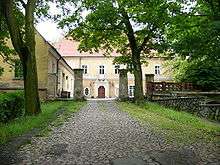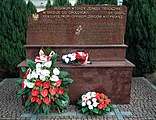Wąsosz
Wąsosz [ˈvɔ̃sɔʂ] (formerly German: Herrnstadt) is a town in Góra County, Lower Silesian Voivodeship, in south-western Poland. It is the seat of the administrative district (gmina) called Gmina Wąsosz. It lies approximately 17 kilometres (11 mi) south-east of Góra, and 53 kilometres (33 mi) north-west of the regional capital Wrocław. The rivers Orla and Barycz meet here.
Wąsosz | |
|---|---|
_market_square_(1).jpg) Market Square (Rynek) in Wąsosz | |
 Coat of arms | |
 Wąsosz | |
| Coordinates: 51°33′N 16°42′E | |
| Country | |
| Voivodeship | Lower Silesian |
| County | Góra |
| Gmina | Wąsosz |
| Town rights | 1290 |
| Government | |
| • Mayor | Zbigniew Stuczyk |
| Area | |
| • Total | 3.24 km2 (1.25 sq mi) |
| Highest elevation | 100 m (300 ft) |
| Lowest elevation | 80 m (260 ft) |
| Population (2019-06-30[1]) | |
| • Total | 2,662 |
| • Density | 820/km2 (2,100/sq mi) |
| Time zone | UTC+1 (CET) |
| • Summer (DST) | UTC+2 (CEST) |
| Postal code | 56-210 |
| Car plates | DGR |
| Website | http://wasosz.eu/ |
As of 2019, the town had a population of 2,662.
History

Wąsosz dates back to the medieval Piast-ruled Kingdom of Poland and its name is of Polish origin. It was granted town rights by Henry III, Duke of Głogów[2] in 1290. It was part of the Duchy of Głogów of fragmented Poland and in the 14th century the local castle of the Piast dukes was built.[2] The castle was unsuccessfully besieged by the Hussites in 1432.[2] In 1520 Wąsosz passed to the bishops of Wrocław and in 1525 it passed again under Piast rule as part of the Duchy of Legnica.[2]
After the dissolution of the duchy in 1675, the town became part of Habsburg-ruled Bohemia, in the 18th century it was annexed by Prussia, in 1871 it became part of Germany, and in 1945 it was reintegrated with Poland. During World War II, in 1943, the Germans established a camp for Polish children up to 5 years of age, which were deemed "racially worthless", and whose mothers were deported to forced labour in Lower Silesia.[3] At least 485 Polish children passed through the camp, and due to its terrible sanitary conditions many died, bodies were transported in wheelbarrows to the local cemetery.[3] 39 children survived until the liberation of the camp.[3] Local pastor Paul Tillmann rescued these children when, during the German evacuation the camp, he opposed the idea of blowing up the building with the children, and looked after them until the town was liberated.[3]
As the result of WWII, the town was assigned to Poland. The totality of its populace was expelled for new Polish settlers to find a new home here.
Gallery
 Catholic Church of Saint Joseph
Catholic Church of Saint Joseph Smolensk air disaster memorial
Smolensk air disaster memorial.jpg) Plaque from 1960 commemorating the 1000th anniversary of Poland, 670th anniversary of Wąsosz and the 15th anniversary of Poland's recovery of Lower Silesia
Plaque from 1960 commemorating the 1000th anniversary of Poland, 670th anniversary of Wąsosz and the 15th anniversary of Poland's recovery of Lower Silesia
References
- "Population. Size and structure and vital statistics in Poland by territorial divison in 2019. As of 30th June". stat.gov.pl. Statistics Poland. 2019-10-15. Retrieved 2020-02-14.
- "Rys historyczny". Gmina Wąsosz (in Polish). Retrieved 8 March 2020.
- Magdelena Sierocińska. "Eksterminacja „niewartościowych rasowo" dzieci polskich robotnic przymusowych na terenie III Rzeszy w świetle postępowań prowadzonych przez Oddziałową Komisję Ścigania Zbrodni przeciwko Narodowi Polskiemu w Poznaniu". Instytut Pamięci Narodowej (in Polish). Retrieved 8 March 2020.